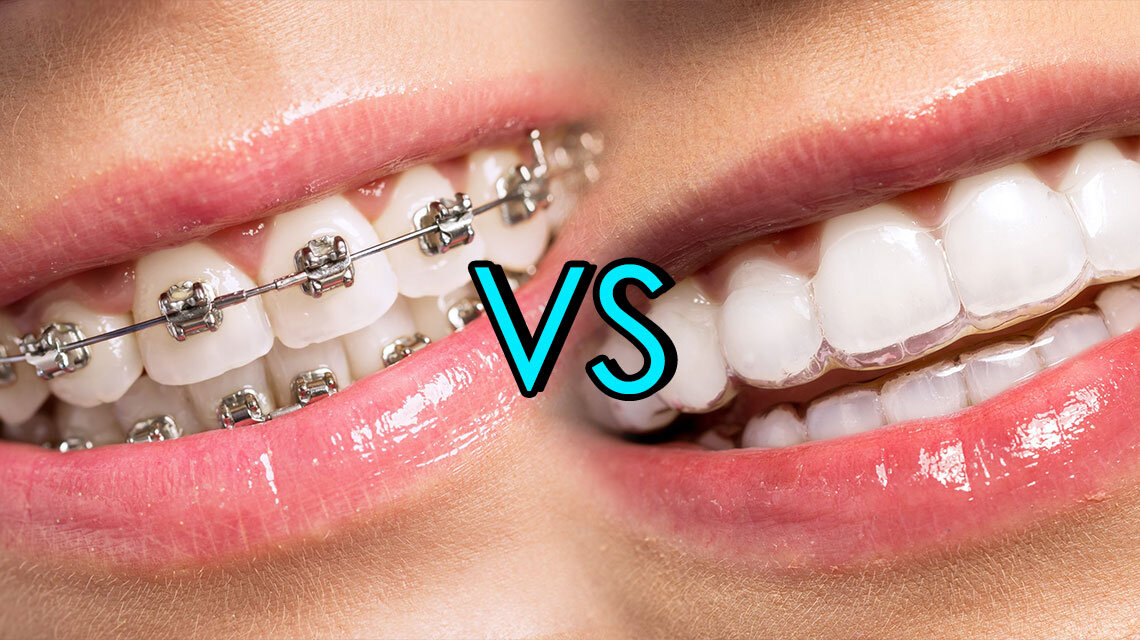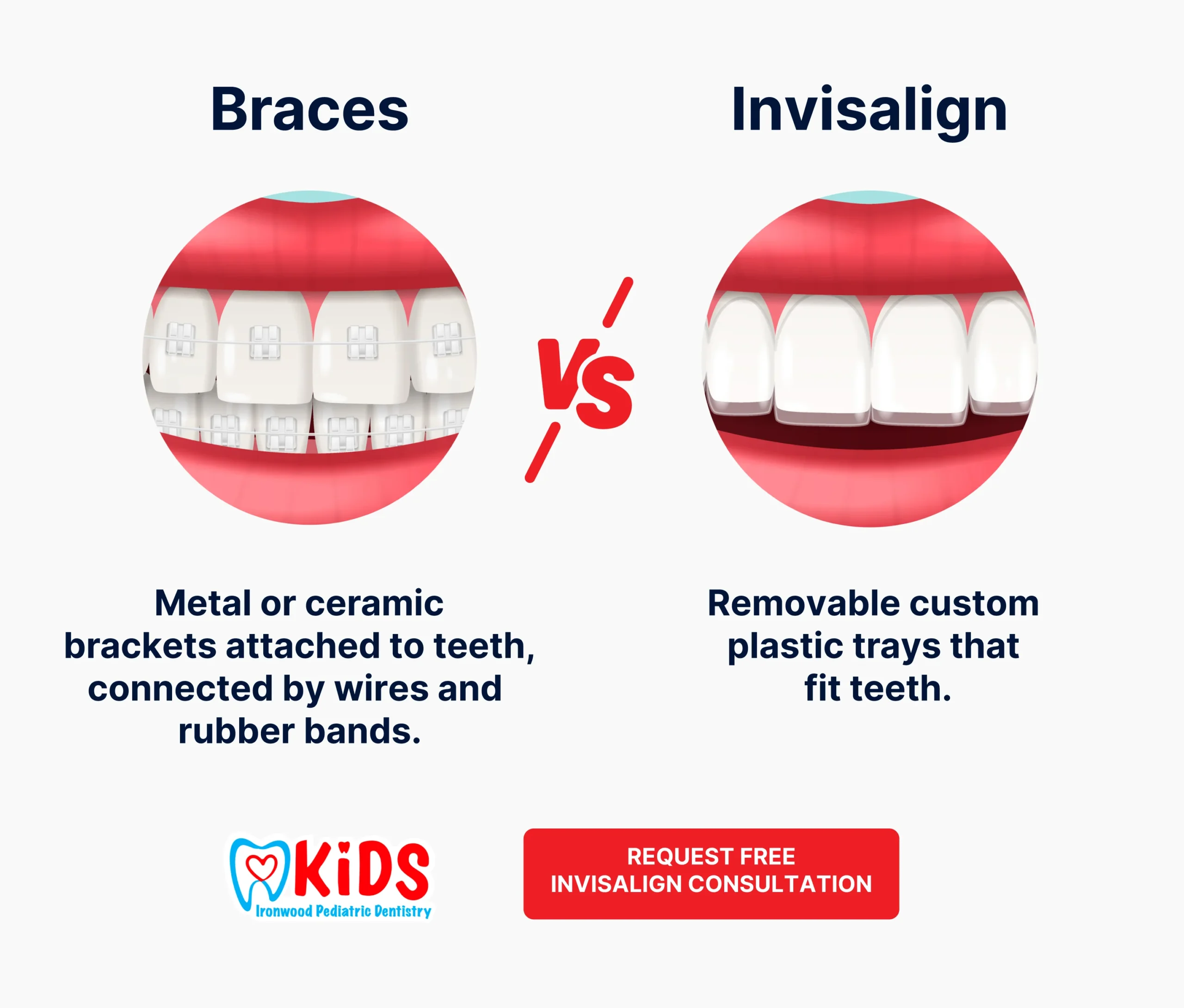Keeping Oral Health While Using Invisalign: Tips for a Smooth Experience
Keeping Oral Health While Using Invisalign: Tips for a Smooth Experience
Blog Article
Invisalign vs. Standard Dental braces: Which Option Is Right for You?
When considering orthodontic therapy, the selection in between Invisalign and conventional braces presents several important variables that merit careful examination. Invisalign uses a very discreet option with removable aligners, while traditional braces supply a more visible yet efficient remedy for extreme imbalance.
Introduction of Therapy Alternatives

In comparison, traditional dental braces include steel braces and cords that are bonded to the teeth. This method applies constant pressure in time to achieve positioning. While reliable for complicated orthodontic concerns, traditional braces call for normal sees for changes and can posture obstacles in keeping oral health as a result of the difficulty of cleaning around brackets and cords.
Both choices have their values, and the option typically rests on details dental problems, way of life choices, and client compliance. Eventually, speaking with an orthodontic professional is critical for identifying one of the most appropriate treatment strategy customized to specific needs. Recognizing the nuances of each alternative can considerably affect the overall success of orthodontic treatment.
Visual Factors To Consider
A substantial aspect influencing the selection in between Invisalign and typical braces is the aesthetic allure each therapy uses. Invisalign aligners are crafted from clear plastic, making them essentially undetectable when put on.
On the other hand, conventional braces consist of steel brackets and wires, which can be much more obvious. While improvements in orthodontic modern technology have led to the advancement of smaller braces and tinted elastics, traditional braces still preserve an even more noticeable account. For some individuals, the exposure of braces might deter them from seeking essential therapy.
Inevitably, the option in between Invisalign and traditional braces might rest on individual preferences pertaining to visual appeals. People that focus on discernment frequently lean towards Invisalign, while those that are less concerned concerning exposure may choose for standard dental braces. Comprehending the visual effects of each choice is important for making an informed choice that straightens with one's way of life and choices.
Comfort and Convenience

In regards to comfort, Invisalign aligners are detachable, enabling individuals to enjoy their favorite foods without restriction and maintain optimum dental health. Cleaning and flossing are simplified, as the aligners can be gotten throughout these routines, whereas traditional braces require careful steering around wires and brackets.
Furthermore, Invisalign's modern system allows for less orthodontic sees. Clients typically obtain numerous collections of aligners at the same time, which can streamline the therapy procedure and lower time invested in the orthodontist's chair. In contrast, typical dental braces necessitate routine modifications, making them less hassle-free for those with hectic schedules. Bonuses Invisalign. Overall, the convenience and comfort of Invisalign make it an appealing option for numerous individuals looking for orthodontic therapy.
Therapy Period and Effectiveness
While both Invisalign and traditional dental braces are efficient in remedying dental imbalances, the period of therapy can differ dramatically between the two choices. Usually, Invisalign treatment can take anywhere from 12 to 18 months, relying on the intricacy of the case. The clear aligners work by progressively changing teeth into their desired settings, and regular follow-ups with an orthodontist help make sure progression remains on track.
On the other hand, standard braces typically require a longer commitment, normally ranging from 18 months to 3 years. This is because of their set nature and making use of wires and brackets, which can be much more reliable for intricate instances and extreme imbalances (Invisalign). The treatment efficiency of typical dental braces is well-documented, as they enable exact adjustments and higher control over tooth movement
Ultimately, the selection between Invisalign and typical dental braces may rest on both the anticipated treatment period and the specific oral concerns at hand. Consulting with an orthodontist is crucial, as they can give tailored referrals based upon specific demands, ensuring the picked approach lines up with preferred durations and results.
Expense Contrast and Insurance Choices
Cost plays a considerable function in the decision-making process for individuals considering orthodontic treatment, whether going with Invisalign or standard dental braces. Generally, the price of Invisalign varieties from $3,000 to $8,000, while standard dental braces usually cost in between $2,000 this website and $6,000. Elements affecting these costs include the intricacy of the instance, the period of treatment, and geographical location.
Several oral insurance policy plans offer partial protection for orthodontic therapies, yet the specifics can vary widely. Usually, typical braces may be extra frequently covered by insurance coverage plans contrasted to Invisalign, which some insurance firms classify as a cosmetic treatment.
In addition, a number of orthodontic techniques offer adaptable settlement strategies, making both therapy alternatives a lot more available. Clients must ask regarding possible funding choices and discount rates for in advance settlements. Examining the total expense, including insurance policy advantages and layaway plan, is crucial for making an informed choice that lines up with both visual choices and budget factors to consider.

Conclusion
In recap, the option in between Invisalign and conventional braces pivots on several aspects, including visual preferences, comfort, therapy period, and expense. Invisalign offers a very discreet, removable choice that assists in dental health and dietary flexibility, while typical braces may be preferable for intricate dental problems and usually come at a lower rate factor. Inevitably, assessment with an orthodontist is vital to analyze private circumstances and determine the most suitable therapy alternative for attaining ideal oral positioning.
When taking into consideration orthodontic treatment, the option in between Invisalign and traditional braces original site presents a number of essential factors that warrant careful analysis.Comparing Invisalign and traditional dental braces exposes distinctive therapy choices for orthodontic correction.While both Invisalign and conventional braces are efficient in dealing with oral misalignments, the period of treatment can vary considerably in between the 2 options.Cost plays a significant duty in the decision-making procedure for individuals taking into consideration orthodontic therapy, whether choosing for Invisalign or traditional braces.In summary, the choice in between Invisalign and traditional dental braces hinges on several aspects, including visual preferences, comfort, therapy duration, and cost.
Report this page